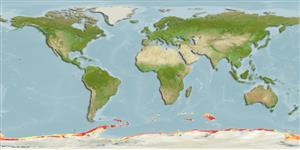Environment: milieu / climate zone / depth range / distribution range
Ecologia
marino demersale; oceanodromo (Ref. 51243); distribuzione batimetrica 1 - 1010 m (Ref. 114491). Polar; 45°S - 78°S, 180°W - 180°E
Circumpolar south of Antarctic Polar Front, but not found in Ross Sea; adults only in higher latitudes (South Orkneys, South Shetlands, Peter Island) and south of the Weddell-Scotia confluence, but adults and juveniles in the region of South Sandwich I, South Georgia and Bouvet. Reported from off the Cape, South Africa and from 43°17'S, 48°55'E (Ref. 4066).
Length at first maturity / Size / Peso / Age
Maturity: Lm 7.4 range ? - ? cm
Max length : 11.5 cm SL maschio/sesso non determinato; (Ref. 114491); 10.3 cm SL (female); peso massimo pubblicato: 15.00 g (Ref. 124149); Età massima riportata: 4 anni (Ref. 94119)
Spine dorsali (totale): 0; Raggi dorsali molli (totale): 14-16; Spine anali 0; Raggi anali molli: 19 - 22
Oceanic and mesopelagic, found in the upper 100 m south of the Antarctic Polar Front but deeper northwards (Ref. 4066). Adults take more euphausiids and also prey upon polychaetes. The diet of juveniles of less than 6 cm SL consists mainly of copepods, with some euphausiids and hyperiids. Possibly the most common myctophid occurring south of the Antarctic Polar Front.
Life cycle and mating behavior
Maturità | Riproduzione | Deposizione | Uova | Fecundity | Larve
Hulley, P.A., 1990. Myctophidae. p. 146-178. In O. Gon and P.C. Heemstra (eds.) Fishes of the Southern Ocean. J.L.B. Smith Institute of Ichthyology, Grahamstown, South Africa. (Ref. 5182)
IUCN Red List Status (Ref. 130435)
Threat to humans
Harmless
Human uses
Pesca:
Informazioni ulteriori
CollaboratoriImmaginiStamps, Coins Misc.SuoniCiguateraVelocitàModalità di nuotoArea branchialeOtolithsCervelliVista
Strumenti
Special reports
Download XML
Fonti Internet
Estimates based on models
Preferred temperature (Ref.
123201): -0.2 - 1.2, mean 0.4 °C (based on 610 cells).
Phylogenetic diversity index (Ref.
82804): PD
50 = 0.5312 [Uniqueness, from 0.5 = low to 2.0 = high].
Bayesian length-weight: a=0.00832 (0.00469 - 0.01475), b=3.09 (2.94 - 3.24), in cm total length, based on LWR estimates for this species & (Sub)family-body (Ref.
93245).
Trophic level (Ref.
69278): 3.2 ±0.4 se; based on diet studies.
Generation time: 6.5 ( na - na) years. Estimated as median ln(3)/K based on 2
growth studies.
Resilienza (Ref.
120179): Medio, tempo minimo di raddoppiamento della popolazione 1.4 - 4.4 anni (K=0.17-0.25; tmax=11).
Fishing Vulnerability (Ref.
59153): Moderate vulnerability (41 of 100).
Nutrients (Ref.
124155): Calcium = 63.5 [23.8, 202.8] mg/100g; Iron = 0.649 [0.225, 1.681] mg/100g; Protein = 15.4 [13.5, 17.5] %; Omega3 = 0.92 [0.39, 2.31] g/100g; Selenium = 13.9 [4.6, 38.8] μg/100g; VitaminA = 49.6 [8.9, 301.0] μg/100g; Zinc = 0.657 [0.347, 1.130] mg/100g (wet weight); based on
nutrient studies.
